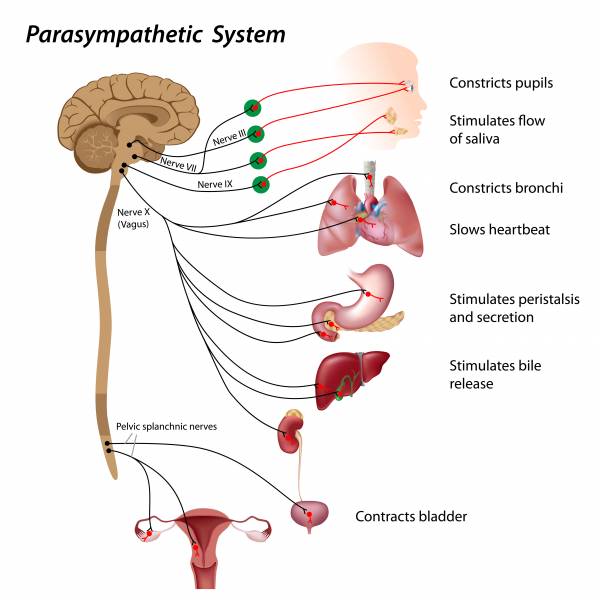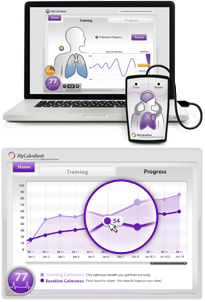Share

Heart Rate Variability (HRV) assessment is becoming an extremely useful tool for measuring the Autonomic Nervous System (ANS) impact on Stress, Heart issues, Fibromyalgia ( FM), Chronic pain, Chronic Fatigue( ME/CFS), autoimmune disorders and many other disease states. Many individuals with these conditions have a low heart rate variability.
A low heart rate variability has been linked to poor sleep, anxiety, inflammation, pain and thinking processes.
What is Heart Rate Variability
The nervous system is made up of the voluntary nervous system and the autonomic nervous system. The autonomic nervous system is the background controller of all body functions.
It has two main parts;
The sympathetic nervous system (SNS) which is the fight or flight response.
The parasympathetic nervous system (PNS) the rest and digest response.
An imbalance in these two systems is often at the core of many illnesses. Being able to measure this and bring these systems back into control represents a significant advance into how to develop health and wellbeing.

HRV is essentially the subtle variations in the time between each heartbeat and is measured in milliseconds. Heart rate variability is not something you can feel or identify without instrumentation. When you feel your own pulse it seems regular and the beats are evenly spaced however when measured precisely it is variable.
There are many factors that the nervous system tracks, moment by moment, which influence heart rate and there is a natural variability between each heartbeat.
The activation of different parts of your nervous system can actually change this level of variability. Greater stimulation of the nervous system will often decrease HRV, which means the time in between heartbeats is more fixed, shorter or unchanging. Being relaxed increases HRV. Stress reduces HRV.
High heart rate variability is a sign of good health, self-regulation and overall resilience. As we age and/or become unwell HRV reduces.
In our clinic, we have found that the majority of individuals with inflammation, fibromyalgia, pain and fatigue have a low HRV which reflects dysregulation of the autonomic nervous system. This usually is due to an increase in SNS activity.
Measurement of HRV is a completely non-invasive way of monitoring your health and can give an accurate measure of your overall well being. The formal test takes 60 minutes and you sit in a chair with heart monitor ( ECG ) sensors attached your inner forearms. Your respiration rate is also recorded by means of a flexible tube around your waist. Other sensors to measure skin conductance and temperature may be used as they are also good indicators of how well your Autonomic Nervous System is functioning.
This is just like an ordinary cardiograph. However, it is not the heart that is being measured but the nervous impulses transmitted via the vagus nerve to the heart. For more information look up “polyvagal theory” on YouTube.)
 By a complicated analysis of the time between each heart-beat, measured in milliseconds (Inter-Beat Interval), the balance between the Sympathetic Nervous System (SNS) and Parasympathetic Nervous System (PNS) can be evaluated. The SNS ( fight and flight responses) and PNS ( rest and digest responses) are the two arms of the autonomic nervous system. The SNS can be likened to the accelerator of your car and the PNS to the brake. Their correct functioning is an interplay between the two. In times of extended stress, and/or illness there can be overstimulation of the SNS and/or withdrawal of the PNS. There is evidence to suggest that constant day to day stress is more difficult to manage than traumatic events.
By a complicated analysis of the time between each heart-beat, measured in milliseconds (Inter-Beat Interval), the balance between the Sympathetic Nervous System (SNS) and Parasympathetic Nervous System (PNS) can be evaluated. The SNS ( fight and flight responses) and PNS ( rest and digest responses) are the two arms of the autonomic nervous system. The SNS can be likened to the accelerator of your car and the PNS to the brake. Their correct functioning is an interplay between the two. In times of extended stress, and/or illness there can be overstimulation of the SNS and/or withdrawal of the PNS. There is evidence to suggest that constant day to day stress is more difficult to manage than traumatic events.
By understanding the balance of the SNS and PNS it is then possible to examine the areas in which lifestyle and other changes can be made to achieve an ideal balance which enhances health.
HRV measurements are often used by athletes to determine when they can train harder, and when they need to rest. My experience suggests that ME/CFS and FM patients can use HRV measurements in a similar way.
 Once a pattern of Autonomic Nervous System nervous system imbalance is determined appropriate remedial steps can be taken.
Once a pattern of Autonomic Nervous System nervous system imbalance is determined appropriate remedial steps can be taken.
For example meditation, yoga, Tai Chi and a personalised breathing rate (called resonant frequency breathing) can all help to increase HRV.
Resonant Frequency (RF) breathing involves breathing at a rate somewhere between 7 and 4.5 breaths per minute. The rate is individualised. Ideally, 3 minutes at a time, 2-3 times a day, will over time, increase your HRV balance. Excessive RF breathing is contraindicated as it can cause an imbalance in other bodily systems.
Overtime balance in the ANS can be achieved. We recommend the Pathways To Wellbeing equation:
Belief in the practice + practise the practice = achieve the outcome.
To determine if this test is appropriate for you please contact us for an appointment. office@daniellewis.com.au.
Self Quantification of Heart Rate Variability.
There is an increasing number of tools for self-measuring of heart rate variability. Each device or smartphone App has it’s own characteristics and this area of personalized medicine is growing very quickly. As yet we have no single recommendation for any particular device. It is our prediction that in a very time measuring HRV will be like measuring blood pressure, a standard clinical tool.
As we have mentioned above stress is known to disrupt the normal HRV spectrum and learning how to circumvent the debilitating influence of stress is one of the purposes of meditation. From a physiological perspective meditation links the functions of the heart with that of the brain. Here is a link to the Meditating Pathways to Wellbeing Audio Guide.
